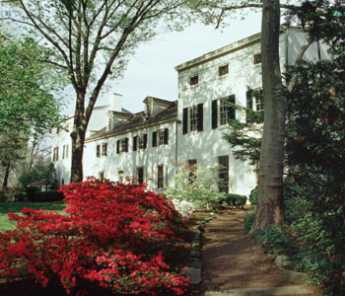Related Topics
The Park and Beyond: East Falls, Germantown, Mt. Airy and Chestnut Hill
Fairmount Park is large enough to split the City from its suburbs, and is partly a playground, partly a museum. East Falls, Germantown and Chestnut Hill are almost a separate world on the far side of the park.
Particular Sights to See:Center City
Taxi drivers tell tourists that Center City is a "shining city on a hill". During the Industrial Era, the city almost urbanized out to the county line, and then retreated. Right now, the urban center is surrounded by a semi-deserted ring of former factories.
City of Rivers and Rivulets
Philadelphia has always been defined by the waters that surround it.
Touring Philadelphia's Western Regions
Philadelpia County had two hundred farms in 1950, but is now thickly settled in all directions. Western regions along the Schuylkill are still spread out somewhat; with many historic estates.
City Hall to Chestnut Hill
There are lots of ways to go from City Hall to Chestnut Hill, including the train from Suburban Station, or from 11th and Market. This tour imagines your driving your car out the Ben Franklin Parkway to Kelly Drive, and then up the Wissahickon.
Philadelphia Places
New topic 2017-02-06 20:19:14 description
The Houses in the Park

|
| Strawberry Mansion |
Fairmount Park is said to be the largest park (7000+ acres) within the limits of an American city, and in fact, maybe just a little bigger than the city can afford to maintain. It was established in the middle of the 19th Century through the efforts of the College of Physicians of Philadelphia to reverse the Industrial Revolution's relentless pollution of Philadelphia's Schuylkill River and the water works. The waterworks were built in 1801 in the mistaken belief that Yellow Fever was caused by pollution; Fairmount Park more accurately responded to the idea that Typhoid Fever was waterborne from upstream pollution. Lemon Hill, the nearby mount containing Robert Morris' Mansion, was purchased to expand the reservoir capacity of the waterworks and thereby made the Art Museum possible where the reservoirs were originally located.
The Park has long constituted a symbolic interval between center city and the suburbs. Since the construction of the river drives and later the expressway, the commute along the river amidst trees and parkland has made an entrance to town a pleasant experience. If the town planners had been able to foresee automobile commuting, they might have anticipated that the sun would be in the driver's eyes coming East during morning rush hour, and in his eyes as he went home toward the West in the evening. Driving safety might perhaps have been impaired by the tendency of this glare to direct attention to the park rather than straight ahead, but nevertheless redoubles the effect of the park views as a daily aesthetic experience. Even the pollution idea had its ambiguous side since animals increase the bacterial runoff from their grazing areas, and the original houses in the park had many pastures. Strip mining, however, allows mineral contaminants to be washed by rain into the watershed. The city waterworks today extract nearly 800 tons of sludge from the water supply, daily. Whatever the effect downstream, the high ground had less malaria and less typhoid than swampy lowlands, so many of the original houses were useful summer retreats for city dwellers during the early years of the city.
The park is governed by the Park Commission, and at one time had its own police force, the fourth largest police force in the state. Started in 1868, the Park Guards changed their name to the Park Police and then became part of the Philadelphia Police in 1972. The original 28 officers had grown to 525, had their own police academy and a proud tradition. It seems very likely that some deep and dirty politics were played in this shift of authority, and it might be a fair guess that some bitterness still survives in the circles who know and care about these things. In 2008 a scarcely-noticed rule change gave the Park to the City Department of Recreation, thus placing it just a little closer to ambitious real estate development. Our present concern, however, is with the houses in the park.
There are seven of them, kept up and maintained by the Philadelphia Museum of Art. Guided tours are provided intermittently by the museum, but since funds are limited only three of the houses are open year round. The others are equally worth a visit but unfortunately, are closed during the height of the spring flowering season. Two of the year-round houses represent the two extremes of Philadelphia culture, since Mount Pleasant was owned by a buccaneer ("privateer") named McPherson who lived at the height of 18th Century elegance, while Cedar Grove was originally a Quaker farmhouse of the greatest simplicity consistent with honest comfort, a style which persisted relatively unchanged until late in the 19th Century. Benedict Arnold and Peggy Shippen looked at Mount Pleasant with an eye to purchase but never lived there because they were called away by national events. With the addition of modern plumbing and air conditioning, Mount Pleasant would be an elegant place to live, even today. McPherson had to sell the place to pay his debts, whereas the Wister and Morris descendants of Cedar Grove still populate the Social Register in large numbers. The two houses completely typify the underlying philosophies of the two leading Philadelphia classes of leadership. One group measures itself by how much it spends, the other group measures success by how much it has left.
REFERENCES
| Treacherous Beauty: Peggy Shippen, the Woman behind Benedict Arnold's Plot to Betray America: Mark Jacob:978-0762773886 | Amazon |
Originally published: Thursday, November 16, 2000; most-recently modified: Friday, May 31, 2019